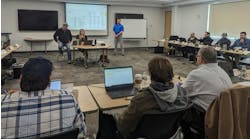Contractor Terry Porter is worried about “windshield time.”
That's the term he uses to describe the time he spends traveling from jobsite to jobsite checking up on his crews. Terry, a contractor in Jenks, Okla., says he'd rather be behind his desk than behind the wheel.
“From a business standpoint, you're better served back at the office drumming up new business instead of driving around checking up on existing business,” he said.
And with the price of gas changing often, Porter added that windshield time is now taking a bite out of his company's bottom line.
“Ideally, I'd like to run all my jobsites without leaving the office,” he said. “I'm just not sure how that's possible.”
What Terry is talking about is what industry insiders have coined Remote Project Management — the ability to manage several jobsites from a central location. And the good news is that two emerging technologies — broadband for cell phones and GPS — are making remote project management both possible and practical for business owners like Terry.
3G broadband on your cell
There's been a lot of buzz about third generation (3G) services for mobile phones, and with good reason. 3G technology brings broadband wireless capabilities to your cell phone. With speeds that rival DSL connections, 3G networks have the potential to allow you to view streaming video, videoconference with colleagues, send and receive large files, and blaze through Web pages.
Track assets with GPS
You've heard of it, but maybe you're not so clear on the ways this powerful technology is being used, and, more importantly, how it can benefit your business.
GPS stands for Global Positioning System. It consists of 24 satellites that circle the earth twice a day, transmitting signal information. GPS receivers on the ground are able to take this information and determine a user's or assets' exact location.
GPS is widely used in fleet management. And many systems now feature “active” GPS, which uses wireless networks to track assets in real time. Active GPS devices leave a “breadcrumb” trail of position markers that the system plots on a map, enabling companies to view vehicle and asset movement as it happens from a Web browser. Many systems also offer an array of reports and alerts, highlighting suspicious or prohibited activity. Some systems are even integrating two-way messaging into their packages, making it easy for drivers and dispatchers to share important information.
But asset management isn't the only area where GPS is making waves. It also plays an equally important role in tracking labor. These systems can tell you not only when your workers clocked in and out, but also exactly where. Your foreman can transmit those attendance and location records over the Internet from his phone or PDA to the office. There, you have a bird's-eye view of all your employee and jobsite information, either in the form of easy-to-read reports or overlaid on a regional map.
GPS-enhanced time and attendance systems are being widely used today.
Rob Rhoades, owner of Diamond R Electric in Enterprise, Ala., said that in just three weeks of using a GPS time-and-attendance system, his payroll expenses have decreased 3%.
“In addition to payroll savings, there is significant savings in time spent doing payroll,” Rhoades said. “It's now a much less laborious task!”
Customers like Rhoades use a GPS-based time-clock system to track the location and attendance of their crews. This software runs on a Windows Mobile PDA, transforming it into a portable time clock that records the exact location of his workers when they clock in and out.
Of course, the only thing that's free about GPS is the incoming signal. To actually do something useful with that signal requires hardware, software and, in many cases, a subscription fee. Most asset tracking packages start at about $500 per asset. Time and location tracking systems like the PocketClock/GPS that my firm sells will run you $700 per device. So clearly, cost is a factor when considering which assets and/or work crews to monitor with GPS.
Terry Porter is impressed with these advances, and not just because they promise to reduce his “windshield time.” He recognizes that in managing their businesses remotely, contractors are actually bridging the gap between themselves and their employees and assets. From a central location, they can:
-
Receive real-time updates from each jobsite
-
Address problems as they occur
-
Know who's at each site any time of the day
-
Reallocate labor as needed throughout the day
“These technologies will save me more than just a trip to my jobsites,” Porter said. “They'll save my company time and money by giving me a better handle on all aspects of the business.”
Scott Prewett is the chief technology officer for Exaktime Inc., Calabasas, Calif., where he designs time and attendance systems for use by the construction trades. He can be reached at 888/788-8463.

